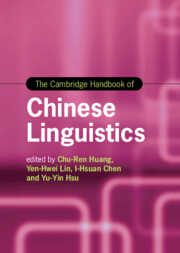Book contents
- The Cambridge Handbook of Chinese Linguistics
- Cambridge Handbooks In Language and Linguistics
- The Cambridge Handbook of Chinese Linguistics
- Copyright page
- Contents
- Figures
- Tables
- Contributors
- Acknowledgments
- Part One Writing System/Neuro-cognitive Processing of Chinese
- 1 Phonological Awareness, Orthography, and Learning to Read Chinese
- 2 Semantic Awareness in Reading Chinese
- Part Two Morpho-lexical Issues in Chinese
- Part Three Phonetic-phonological Issues in Chinese
- Part Four Syntax-semantics, Pragmatics, and Discourse Issues
- Index
- References
1 - Phonological Awareness, Orthography, and Learning to Read Chinese
from Part One - Writing System/Neuro-cognitive Processing of Chinese
Published online by Cambridge University Press: 04 August 2022
- The Cambridge Handbook of Chinese Linguistics
- Cambridge Handbooks In Language and Linguistics
- The Cambridge Handbook of Chinese Linguistics
- Copyright page
- Contents
- Figures
- Tables
- Contributors
- Acknowledgments
- Part One Writing System/Neuro-cognitive Processing of Chinese
- 1 Phonological Awareness, Orthography, and Learning to Read Chinese
- 2 Semantic Awareness in Reading Chinese
- Part Two Morpho-lexical Issues in Chinese
- Part Three Phonetic-phonological Issues in Chinese
- Part Four Syntax-semantics, Pragmatics, and Discourse Issues
- Index
- References
Summary
Phonological awareness refers to a speaker’s knowledge of the phonological structure of the language. The study of phonological awareness has traditionally been associated with the study of reading. As reading Chinese involves an orthography that does not directly encode phonology, the issue of phonological awareness in Chinese speakers and learners has been an intriguing issue. In this chapter, we examine this issue by synthesizing research from reading, orthography, phonology, and, most crucially, from recent studies in Chinese linguistics. In the process, we identify several strong arguments for phonological awareness for Mandarin speakers.
- Type
- Chapter
- Information
- The Cambridge Handbook of Chinese Linguistics , pp. 3 - 22Publisher: Cambridge University PressPrint publication year: 2022

